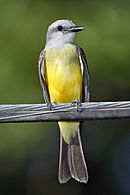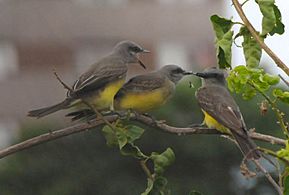Tropical kingbird facts for kids
Quick facts for kids Tropical kingbird |
|
|---|---|
 |
|
| T. m. melancholicus The Pantanal, Brazil |
|
| Conservation status | |
| Scientific classification | |
| Kingdom: | |
| Phylum: | |
| Class: | |
| Order: | |
| Family: | |
| Genus: |
Tyrannus
|
| Species: |
T. melancholicus
|
| Binomial name | |
| Tyrannus melancholicus (Vieillot, 1819)
|
|
The tropical kingbird (Tyrannus melancholicus) is a large tyrant flycatcher. This bird breeds from southern Arizona and the lower Rio Grande Valley of Texas in the United States through Central America, South America as far as south as central Argentina and western Peru, and on Trinidad and Tobago. Birds from the northernmost and southern breeding areas migrate to warmer parts of the range after breeding.
Description and ecology
An adult tropical kingbird is 22 cm (8.7 in) long and weighs 39 g (1.4 oz). The head is pale gray, with a darker eye mask (area around its eyes), an orange crown stripe, and a heavy gray bill. The back is grayish-green, and the wing and forked tail are brown. The throat is pale gray, becoming olive-colored on the breast, with the rest of the underparts being yellow. Both male and female are similar, but young birds have pale buff edges on the wing coverts.
The call is a high-pitched twittering trill, tree-e-e-e-e-e-e, with a more complex version sung by the male at dawn.
Their breeding habitat is semi-open areas with trees and shrubs, including gardens and roadsides. Tropical kingbirds like to view their surroundings from an open perch, usually high in a tree. They take long flights to catch insects in mid-air, which is called hawking. They sometimes hover to pick food off of plants, which is called gleaning. They also eat some fruit.
These birds will defend their territory against intruders, even much larger birds such as toucans, caracaras or hawks.
They make a flimsy cup nest in a tree. The eggs are cream-colored with reddish-brown marks. The female incubates the typical clutch of two or three eggs for 16 days. After they hatch, it is about 18–19 more days until fledging.
The tropical kingbird is not considered a threatened species by the IUCN. This is because this bird is very common and they adapt well to changes in their environment.
-
T. m. satrapa, Panama
- Nesting Tyrannus melancholicus[1]
See also
 In Spanish: Tirano melancólico para niños
In Spanish: Tirano melancólico para niños




